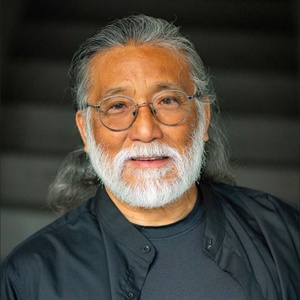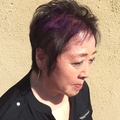It’s hard to believe that this month we celebrate the 100th edition of Nikkei Uncovered: a poetry column! We wanted to feature two poets for this special milestone—Hawai‘i based poet & filmmaker Richard Hamasaki, and Los Angeles based writer & community leader Miya Iwataki. Each of their poems have a fight emerging through their phrases, urging us to remember, towards poetry that “ruptures imprisoned memories,” towards our “cultural soul,” towards action and community.
Both Miya and Richard have poetry featured in the forthcoming anthology, The Gate of Memory: Poems by Descendants of Nikkei Wartime Incarceration (eds., Brynn Saito and Brandon Shimoda, Haymarket Books, 2025). Brynn and I are co-hosting a special reading during the annual AWP conference (the largest annual writers conference, held this year in LA) at the Tateuchi Democracy Forum at JANM, 7 p.m., Thursday March 27. The event is free to the public and will feature over a dozen of the poets from the anthology ahead of its official April release. Please join us. And happy 100th Nikkei Uncovered column!
— traci kato-kiriyama
* * * * *
Poet and independent filmmaker & producer Richard Hamasaki has been active in Hawai‘i’s literary and arts community for over fifty years, collaborating with creatives locally, regionally, and internationally. In 1976, he independently published seven issues of Seaweeds and Constructions, an art and literary magazine ending its run after the tragic death of his friend, mentor, and co-editor Wayne Kaumualii Westlake (1947–1984). In 2024, Richard gifted Tāmaki Paenga Hira Auckland War Memorial Museum his extensive Hawaiʻi/Pacific library along with his and his brother Mark Hamasaki’s silkscreens, printed matter, selected photographs, and more, from their ʻElepaio Press collective and archive.
Behind Barbed Wire
for Grandpa Senri and Grandma Yoshino Nao
Injustice provokes poetry
ruptures imprisoned memories
prolongs the will despite deprivation
laughing in its sleep, sullen even in pain
alone, withdrawn from its own bones’ rhythm
groaning this evening, the tide too low for flight
Like shadows or a long and tender serpent’s tongue
it reaches, picks rusted locks, opens gates
drifts through fences
beyond walls and barriers
tastes, then drinks
mutters and moans
finds humor even in poor company
humiliations lingering in its mind
Gazing at mountain peaks
reverberating with urgency
past censors, iron bars,
armed guards, through barbed wire
this ancient electricity heats the brain
with thoughts incarnadine
resurging family stories
of cunning artistry
of grandparents hiking through desert
finding then carving stone
grinding black ink with water
wet brushes touching paper
*This poem was originally published in From the Spider Bone Diaries, Poems and Songs (Honolulu: Kalamakū Press, 2000), reprinted by the University of Hawaiʻi Press (Honolulu, 2001), and forthcoming in The Gate of Memory: Poems by Descendants of Nikkei Wartime Incarceration (eds., Brynn Saito and Brandon Shimoda, Haymarket Books, 2025).
* * * * *
Miya Iwataki’s life experience as an AAPI woman activist, Japanese American warrior for Justice and Reparations; KPFK-FM East Wind Radio host; architect of diversity and cultural competency programs for LA County Health; have Inspired a lifelong respect for cultures, community and commitment to justice and equity. Her poetry, writings and columns are shaped by an appreciation for the profound effect of words and language on our culture and our times. She is a member of Nikkei Progressives, NCRR and Nat’l Nikkei Reparations Coalition fighting to win Black Reparations today. As Vice President of Little Tokyo Historical Society, she’s working to preserve the history, legacy and cultural soul of Little Tokyo in the face of gentrification.
WE ARE LITTLE TOKYO
In 1886 a Japanese seaman named Hamanosuke Shigeta jumped ship, came to LA and opened the first J-owned business (Kame Café). A small Issei community followed and the first Little Tokyo was born. In 2024, as Little Tokyo celebrated our 140th year, we were named to the list of America’s 11 Most Endangered Historic Places by the National Trust for Historic Preservation.
Once there were 43
Little Tokyos
Japan Towns
Nihonmachis
Once there were 43
Today only three historic Japan Towns survive
Once
Little Tokyo was
Extended family
Weddings, anniversaries, funeral
Chinameshi dinners at
Far East Café or San Kwoh Loh
Once
Mom-and-pop shops
Dotted every block
with enticing whiffs of grilled teriyaki
and steaming bowls of chashu udon
And wispy tendrils of scented incense
Wafting thru Buddhist Temples
Once
Children’s laughter was heard
While scampering thru streets
Under watchful eyes of
Smiling shop owners
Who slipped them sweet treats
Once
Little Tokyo was our Cultural home
Heart of the Japanese American community.
And the
US denied us citizenship
CA denied land ownership
L.A. covenants restricted our housing
WWII
120,000 – Seized, family-separated, imprisoned
Barbed wire, armed guard concentration camps
And Little Tokyo was left a ghost town.
Then a brief revival as Bronzeville
When we came back
No “welcome home,” or even “Sorry, my bad.”
We rebuilt – our family, our lives
With mutual support, brick and mortar
And L.A. Civic Center decided to expand –
Urban Removal encroaching
Displacing hundreds – fresh out of Camp,
History repeating itself
Another Civic Center expansion – 1970s
Meets Resistance!
A community united – standing up, standing together
Fighting evictions, demanding concessions – compassion.
This unity, fighting spirit and hope
A reawakening of Issei pioneer grit
Igniting the community to stand even stronger
To win Justice and Reparations
To Redress the wrongs of Camp
This unity, fighting spirit and hope
Bringing us through the Pandemic – battered but breathing
Today the new Metro hub – a lure of Gentrification enflaming
A feeding frenzy of shark – skin suited developers
Predators pursuing those made vulnerable by age and spiking rents
No compassion for “neighborhood” or “community”
Or legacy or history
Or generational values
Or what it means for a non-majority people to
Fight for our cultural legacy and integrity
We are Little Tokyo.
We are home of the firsts
East West Players – 1st AAPI Theatre Group
Visual Communications – 1st AAPI multi-media organization
Japanese American National Museum
Birthplace of Shabu Shabu restaurant, California Roll
Fortune Cookies, frozen fish sticks.
We are Dodger Blue and Shohei murals
We are Nisei Week Parades, Oshogatsu, Autumn Tanabata festivals
We honor our ancestors in celebrations, story, art, Japanese gardens,
Through the fierce preservation of our cultural, historic, and physical legacy
We are a public square for speaking out for justice!
Despite Cold hearts and Cold Storage
Graffiti and gentrification
We gain strength as cohorts of a shared struggle
From Chinatown to Cambodia Town
From Echo Park to Leimert Park
Fighting for survival from
The sledgehammer of gentrification, displacement, outside developers, rising rents
We are the Cultural Keepers of our Neighborhood
We share this call to save our communities
Our history
Our legacy
Our cultural soul
To Save Little Tokyo!
I was invited to read a poem on Little Tokyo at the Swearing In Ceremony of the Hon. Ysabel Jurado, the new Councilmember representing Little Tokyo. With this poem, I welcomed her to Little Tokyo and invited her to become a part of our story – our continuing struggle to Save Little Tokyo.
*This poetry is copyrighted by Miya Iwataki (2025)
© 2000 Richard Hamasaki; © 2025 Miya Iwataki


















